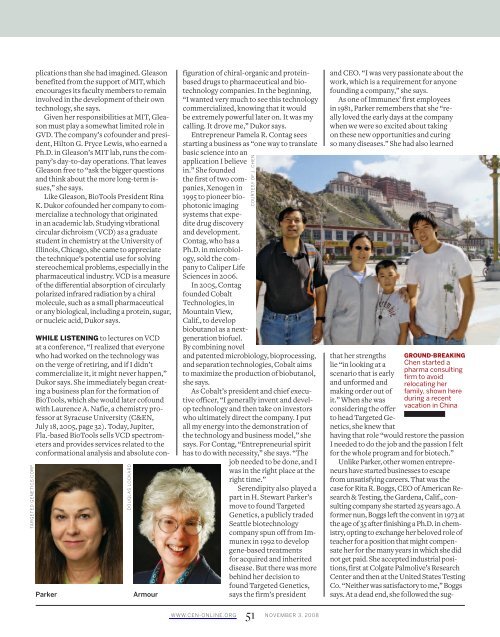Chemical & Engineering News Digital Edition ... - IMM@BUCT
Chemical & Engineering News Digital Edition ... - IMM@BUCT
Chemical & Engineering News Digital Edition ... - IMM@BUCT
You also want an ePaper? Increase the reach of your titles
YUMPU automatically turns print PDFs into web optimized ePapers that Google loves.
TARGETED GENETICS CORP.<br />
plications than she had imagined. Gleason<br />
benefited from the support of MIT, which<br />
encourages its faculty members to remain<br />
involved in the development of their own<br />
technology, she says.<br />
Given her responsibilities at MIT, Gleason<br />
must play a somewhat limited role in<br />
GVD. The company’s cofounder and president,<br />
Hilton G. Pryce Lewis, who earned a<br />
Ph.D. in Gleason’s MIT lab, runs the company’s<br />
day-to-day operations. That leaves<br />
Gleason free to “ask the bigger questions<br />
and think about the more long-term issues,”<br />
she says.<br />
Like Gleason, BioTools President Rina<br />
K. Dukor cofounded her company to commercialize<br />
a technology that originated<br />
in an academic lab. Studying vibrational<br />
circular dichroism (VCD) as a graduate<br />
student in chemistry at the University of<br />
Illinois, Chicago, she came to appreciate<br />
the technique’s potential use for solving<br />
stereochemical problems, especially in the<br />
pharmaceutical industry. VCD is a measure<br />
of the differential absorption of circularly<br />
polarized infrared radiation by a chiral<br />
molecule, such as a small pharmaceutical<br />
or any biological, including a protein, sugar,<br />
or nucleic acid, Dukor says.<br />
Parker<br />
DOUGLAS LOCKARD<br />
Armour<br />
WHILE LISTENING to lectures on VCD<br />
at a conference, “I realized that everyone<br />
who had worked on the technology was<br />
on the verge of retiring, and if I didn’t<br />
commercialize it, it might never happen,”<br />
Dukor says. She immediately began creating<br />
a business plan for the formation of<br />
BioTools, which she would later cofound<br />
with Laurence A. Nafie, a chemistry professor<br />
at Syracuse University (C&EN,<br />
July 18, 2005, page 32). Today, Jupiter,<br />
Fla.-based BioTools sells VCD spectrometers<br />
and provides services related to the<br />
conformational analysis and absolute configuration<br />
of chiral-organic and proteinbased<br />
drugs to pharmaceutical and biotechnology<br />
companies. In the beginning,<br />
“I wanted very much to see this technology<br />
commercialized, knowing that it would<br />
be extremely powerful later on. It was my<br />
calling. It drove me,” Dukor says.<br />
Entrepreneur Pamela R. Contag sees<br />
starting a business as “one way to translate<br />
basic science into an<br />
application I believe<br />
in.” She founded<br />
the first of two companies,<br />
Xenogen in<br />
1995 to pioneer biophotonic<br />
imaging<br />
systems that expedite<br />
drug discovery<br />
and development.<br />
Contag, who has a<br />
Ph.D. in microbiology,<br />
sold the company<br />
to Caliper Life<br />
Sciences in 2006.<br />
In 2005, Contag<br />
founded Cobalt<br />
Technologies, in<br />
Mountain View,<br />
Calif., to develop<br />
biobutanol as a nextgeneration<br />
biofuel.<br />
By combining novel<br />
and patented microbiology, bioprocessing,<br />
and separation technologies, Cobalt aims<br />
to maximize the production of biobutanol,<br />
she says.<br />
As Cobalt’s president and chief executive<br />
officer, “I generally invent and develop<br />
technology and then take on investors<br />
who ultimately direct the company. I put<br />
all my energy into the demonstration of<br />
the technology and business model,” she<br />
says. For Contag, “Entrepreneurial spirit<br />
has to do with necessity,” she says. “The<br />
job needed to be done, and I<br />
was in the right place at the<br />
right time.”<br />
Serendipity also played a<br />
part in H. Stewart Parker’s<br />
move to found Targeted<br />
Genetics, a publicly traded<br />
Seattle biotechnology<br />
company spun off from Immunex<br />
in 1992 to develop<br />
gene-based treatments<br />
for acquired and inherited<br />
disease. But there was more<br />
behind her decision to<br />
found Targeted Genetics,<br />
says the firm’s president<br />
COURTESY OF J. CHEN<br />
and CEO. “I was very passionate about the<br />
work, which is a requirement for anyone<br />
founding a company,” she says.<br />
As one of Immunex’ first employees<br />
in 1981, Parker remembers that she “really<br />
loved the early days at the company<br />
when we were so excited about taking<br />
on these new opportunities and curing<br />
so many diseases.” She had also learned<br />
that her strengths<br />
lie “in looking at a<br />
scenario that is early<br />
and unformed and<br />
making order out of<br />
it.” When she was<br />
considering the offer<br />
to head Targeted Genetics,<br />
she knew that<br />
GROUND-BREAKING<br />
Chen started a<br />
pharma consulting<br />
firm to avoid<br />
relocating her<br />
family, shown here<br />
during a recent<br />
vacation in China<br />
having that role “would restore the passion<br />
I needed to do the job and the passion I felt<br />
for the whole program and for biotech.”<br />
Unlike Parker, other women entrepreneurs<br />
have started businesses to escape<br />
from unsatisfying careers. That was the<br />
case for Rita R. Boggs, CEO of American Research<br />
& Testing, the Gardena, Calif., consulting<br />
company she started 25 years ago. A<br />
former nun, Boggs left the convent in 1973 at<br />
the age of 35 after finishing a Ph.D. in chemistry,<br />
opting to exchange her beloved role of<br />
teacher for a position that might compensate<br />
her for the many years in which she did<br />
not get paid. She accepted industrial positions,<br />
first at Colgate Palmolive’s Research<br />
Center and then at the United States Testing<br />
Co. “Neither was satisfactory to me,” Boggs<br />
says. At a dead end, she followed the sug-<br />
WWW.CEN-ONLINE.ORG 51 NOVEMBER 3, 2008

















